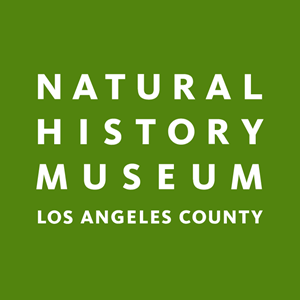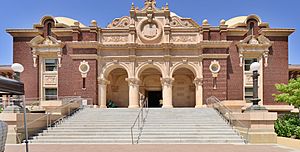Natural History Museum of Los Angeles County facts for kids
 |
|

The east entrance and façade
|
|
| Established | 1913 |
|---|---|
| Location | Exposition Park Los Angeles, California |
| Type | Natural history museum |
| Visitors | about 1 million annually |
| Public transit access | |
The Natural History Museum of Los Angeles County is a huge museum in the Western United States. It focuses on both natural history and human history. You can find it in Exposition Park, Los Angeles. It's right next to the California Science Center.
The museum has almost 35 million items in its collections. These include specimens and artifacts. They tell stories from 4.5 billion years of history! Many of these items are for research, not just for showing in exhibits.
This museum is connected to two other museums in the Greater Los Angeles area. These are the Page Museum at the La Brea Tar Pits and the William S. Hart Ranch and Museum in Newhall. Together, these three museums want to "inspire wonder, discovery, and responsibility for our natural and cultural worlds."
Contents
Museum History and Growth
The Natural History Museum opened in Exposition Park in 1913. It was first called The Museum of History, Science, and Art. A group of people who loved museums started it in 1910. The main building is very special. It has marble walls, a dome, and columns. This building is even on the The National Register of Historic Places.
Over the years, the museum grew bigger. New parts were added in 1925, 1930, 1960, and 1976. In 1961, the museum split into two parts. One part became The Los Angeles County Museum of History and Science. The other part became the Los Angeles County Museum of Art (LACMA). LACMA moved to a new place in 1965. Then, the Museum of History and Science changed its name. It became The Los Angeles County Museum of Natural History. Later, it changed its name again to what it is today.
In 2003, the museum started a big project. They wanted to make their exhibits and visitor experience even better. In 2010, they reopened their main rotunda from 1913. This part of the building was made stronger to handle earthquakes. They also opened a new exhibit called "Age of Mammals." The exciting Dinosaur Hall opened in July 2011. A new exhibit about Los Angeles history, "Becoming Los Angeles," opened in 2013. The outdoor Nature Gardens and Nature Lab also opened in 2013. These areas help visitors learn about wildlife in Los Angeles.
In 2024, the museum opened a new area called the NHM Commons. This new space is about 60,000 square feet. It includes new buildings, renovated areas, and outdoor gardens. The Commons is on the southwest side of the museum. It is a community space with indoor and outdoor areas. These include a welcome area, a lobby with a shop, a theater, a café, and a plaza.
Museum Collections and Research
The museum has many different collections. Experts study these collections in various fields. Here are some of the main areas:
- Annelids (like worms)
- Anthropology (study of humans) and Archaeology (study of old cultures)
- Crustaceans (like crabs and lobsters)
- Echinoderms (like starfish)
- Entomology (study of insects)
- Ethnology (study of cultures)
- Herpetology (study of reptiles and amphibians)
- History
- Ichthyology (study of fish)
- Invertebrate paleontology (study of old spineless animals)
- Malacology (study of mollusks like snails)
- Mammalogy (study of mammals)
- Mineralogy (study of minerals)
- Ornithology (study of birds)
- Vertebrate paleontology (study of old animals with backbones)
The museum has three floors of permanent exhibits. Some of the most popular displays show animal habitats. There are also exhibits about dinosaurs and pre-Columbian cultures. The Ralph M. Parsons Discovery Center and Insect Zoo are also very popular. The new Nature Lab helps you learn about city wildlife in Southern California.
The museum's collections are very strong in many areas. The mineralogy collection is highly valued. The collection of Pleistocene fossils is also very important. This is because many amazing specimens came from the nearby La Brea Tar Pits.
The museum has almost 30 million items related to marine zoology. This includes one of the world's largest collections of marine mammal bones. It has over 5,000 specimens. This collection is second in size only to the one at The Smithsonian. The museum also keeps historical documents. These are found in The Seaver Center for Western History Research.
Special Exhibits and Events
The museum often has special exhibits. These add to its collections and help with its mission. Some past special exhibits included "Mummies" and "Pterosaurs" in 2016. The museum has also hosted exhibits that connect to pop culture. For example, there was an exhibit about House of the Dragon in 2022.
There have also been special exhibits about Los Angeles. One was called Becoming Los Angeles. It showed the city's history, divided into before and after 1929. Another exhibit was L.A. Underwater. This exhibit showed almost 40 fossils from a time when Los Angeles was under the sea.
Every spring and summer, the museum has a butterfly pavilion outside. In the fall, a spider pavilion is set up in the same spot. Since 2017, the museum has had a special exhibit about P-22. P-22 was a famous mountain lion that lived in nearby Griffith Park.
Museum Architecture
The museum has added new parts to its original building over the years. The rotunda is one of the museum's most beautiful and popular areas. It opened when the museum first started in 1913. This room has marble columns and a stained glass dome. It also holds the first piece of public art paid for by Los Angeles County. This is a statue by Julia Bracken Wendt called Three Muses. It represents History, Science, and Art. This hall is very unique in Los Angeles. It has often been used as a place to film movies and TV shows.
Filming Locations
The museum has been a popular spot for filming:
- In 1996, Sheryl Crow filmed her "If It Makes You Happy" music video here. It was shot in the museum's Endangered Species Hall.
- Honda filmed its "Matthew Broderick's Day Off" commercial at the museum.
- In 2025, Machine Gun Kelly filmed his music video for his song "vampire diaries" at the museum.
Gallery
-
Triceratops mount in the Natural History Museum of Los Angeles County
See also
 In Spanish: Museo de Historia Natural del Condado de Los Ángeles para niños
In Spanish: Museo de Historia Natural del Condado de Los Ángeles para niños







